Nancy Barrington can’t remember the first time she visited Pochet Island. “I’m sure Mom and Dad brought me when I was just a few weeks old,” she says, “and it’s been home ever since.” Barrington’s ancestor Gilbert Russell Payson Sr. purchased the 150-acre island, which is pronounced “poachy,” not “poachet,” in 1886. He also bought two other neighboring estuarine islands, Hog and Sampson, both uninhabited (the latter not to be confused with the Sampsons Island bird sanctuary near Cotuit). Wealthy from cotton mills he owned in New Hampshire, Payson wanted the islands as his private duck hunting grounds.
That same year, Payson contracted a local shipbuilder to construct a large main house, the building materials brought over at low tide on horse-drawn buckboard from the outer beach at Nauset. It was called the New House, to distinguish it from an older structure, a full Cape now called the Old House, that was brought to the island in the early 1800s. These and three cottages built later are now used by his descendants.
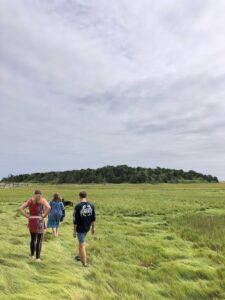
According to family lore, Payson was faced with tremendous debt after being swindled by a business partner and was forced to sell his properties in Watertown and Brookline. “But nobody wanted to buy three islands on Cape Cod at the time,” says Barrington, “so they stayed in the family.” After Payson died in 1891, ownership went to his children, whose descendants, now numbering in the hundreds, still manage the island as a trust.
Barrington says the island’s name derives from a Wampanoag word that means “the dividing place” because it was an in-between meeting location for members of the Monomoyick and Nauset tribes. By the time her ancestor purchased the land, it was a sheep farm and barren of all trees and large shrubs. Later the family would plant hardwood trees and do controlled burns to keep the meadows intact, but after a fire nearly took out the New House, that practice was stopped in the early 20th century, and over the decades thick copses of pine, oak, holly, poison ivy, and bittersweet grew to cover much of the island.
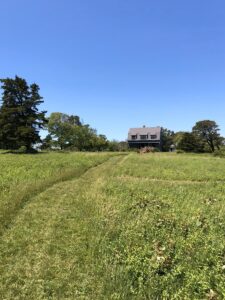
When the National Seashore proposed to take over the family’s land in 1961 to guard against future resort development, the descendants made the case that the islands are difficult to access and an awful lot of work to maintain. The officials agreed and the land was put into a perpetual conservation easement owned by the family, who promised to never to develop the islands, and never to build another structure or even replace one if it burns or is destroyed in a storm. In return, the family maintains the paths and meadows from the rampant growth of invasive plants, while welcoming the public to walk the trails.
“Keeping Pochet going is still very much a Payson family project,” says Barrington. “There are four miles of trails to tend and some 40 acres of meadows; each acre takes a day to mow by my brothers and cousins.”
With hundreds of bird species on the island, Pochet is a favorite, if remote, destination for birdwatchers. “It’s a fall hotspot for migrating birds,” says Mark Faherty, Mass Audubon’s Science Coordinator for Cape Cod. “But the mile-plus-long hike along the sand from Nauset Beach parking lot keeps less hardy birders from visiting.”
Though family members can row their guests over from Barley Neck, public visitors are welcome to hike over from the southern part of Nauset Beach, or they can approach by water in kayaks or canoes. “We just ask that they not use our family dock because it’s small and rickety,” says Barrington.
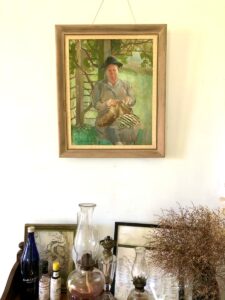
Hikers must pay careful attention to tide charts since the marsh paths and small bridge are useable only at low tide, with many of the trails becoming deeply mucky in wet weather. Barrington recounts how she was trapped for eight hours on the island recently when she lost track of time and couldn’t get back over the bridge due to unusually high tides. As the dunes succumb to storms and erosion, the marsh has become even more prone to flooding.
Among the houses, which remain private, the three-story New House, which Barrington shares with her two brothers and their families, is the architectural centerpiece of the island. Constructed primarily with wooden pegs, it seems frozen in time in charming and idiosyncratic ways. Height marks on a kitchen wall date back over a century. A hand-painted mural of a sailboat and other artworks hang among heirloom furniture and photographs of ancestors and the island still in its barren state.
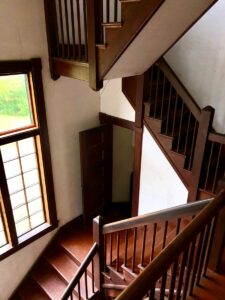
Modern conveniences barely exist. There’s no indoor plumbing, only a two-seater outhouse and composting toilet. Until recently there was no electricity, though now a generator and solar panels power two outlets and heat water for one faucet. After the hand-cranked well pump gave out, the family put in a new electric model. “You can’t get a pump for a well that’s not electric anymore,” says Barrington.
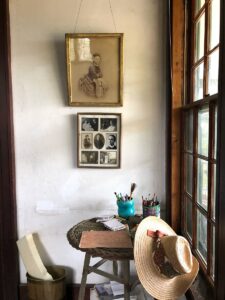
“We don’t consider ourselves the owners of this place,” she says, we’re just the stewards.” Barrington, a former computer programmer, learned so much about restoring the original windows in her house that she started her own business, Window Restoration Cape Cod, in 2015. “There’s nothing I like more than just sitting on the porch and looking over the meadow to the beach,” she says. “I was always a type A personality. I was always busy. Now I’ve learned to stop, because every day is different. At night it’s really dark; it’s quiet. You can hear the ocean and not anything else — except for the coyotes, of course.”
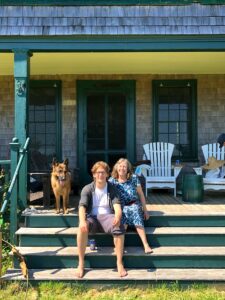
For more information search “Pochet Island” on alltrails.com. Several local walking clubs and the Orleans Conservation Trust lead guided walks in the summer.



